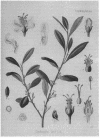Abstract
OBJECTIVE--To study the immediate and long term clinical success of percutaneous transluminal coronary balloon angioplasty in patients over 70 years old. DESIGN--Patients undergoing percutaneous transluminal angioplasty were prospectively entered in a specially designed database. The clinical and angiographic data of all patients over 70 were reviewed. Follow up data were collected by interview, during outpatient visits, by questionnaire, or through the referring physician. SETTING--A tertiary referral cardiac centre. PATIENTS--166 patients over 70 (median 73, range 70-84) underwent coronary angioplasty because of unstable angina (81 patients), stable angina (76 patients), or acute myocardial infarction (nine patients). RESULTS--The initial clinical success rate was 86% (142 of 166 patients). A major procedural complication occurred in 10 patients (6%): four patients (2%) died, six patients (4%) underwent emergency bypass surgery, and five patients (3%) sustained an acute myocardial infarction. In 14 patients (8%) coronary angioplasty did not significantly reduce the diameter stenosis but there were no associated complications. A total of 226 lesions were attempted. The initial angiographic success rate was 192 out of 226 lesions (85%). The median follow up was 21 (range 0.5-66) months. Sixteen patients (10%) died during follow up, eight patients (5%) sustained a non-fatal myocardial infarction, 21 patients (13%) underwent a second or third balloon dilatation, and 17 patients (10%) underwent elective bypass surgery. Of the 146 survivors, 99 patients (68%) had sustained clinical improvement. The estimated survival at four years (Kaplan-Meier method) was 89 (SD 4)%. The event free survival at four years for the total study population was 61 (8)%. Multivariate logistic regression analysis showed that the extent of vessel disease was the only independent predictive factor for event free survival: the event free survival rate was 81 (10)% at four years for patients with single vessel disease, compared with 45 (12)% for patients with multivessel disease. CONCLUSIONS--Coronary angioplasty in patients over 70 was a safe and effective treatment for obstructive coronary artery disease. The extent of vessel disease, and not the completeness of revascularisation, was the only independent predictive factor for event free survival.
Full text
PDF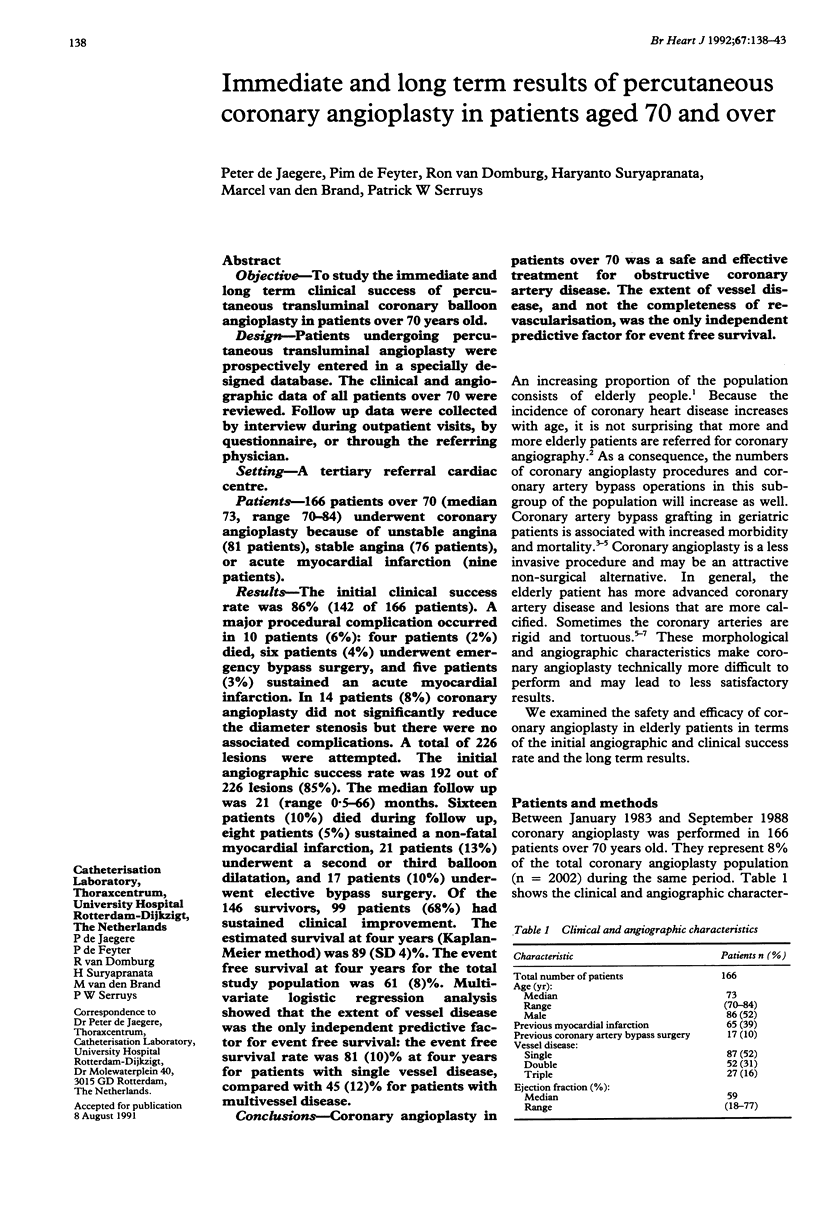
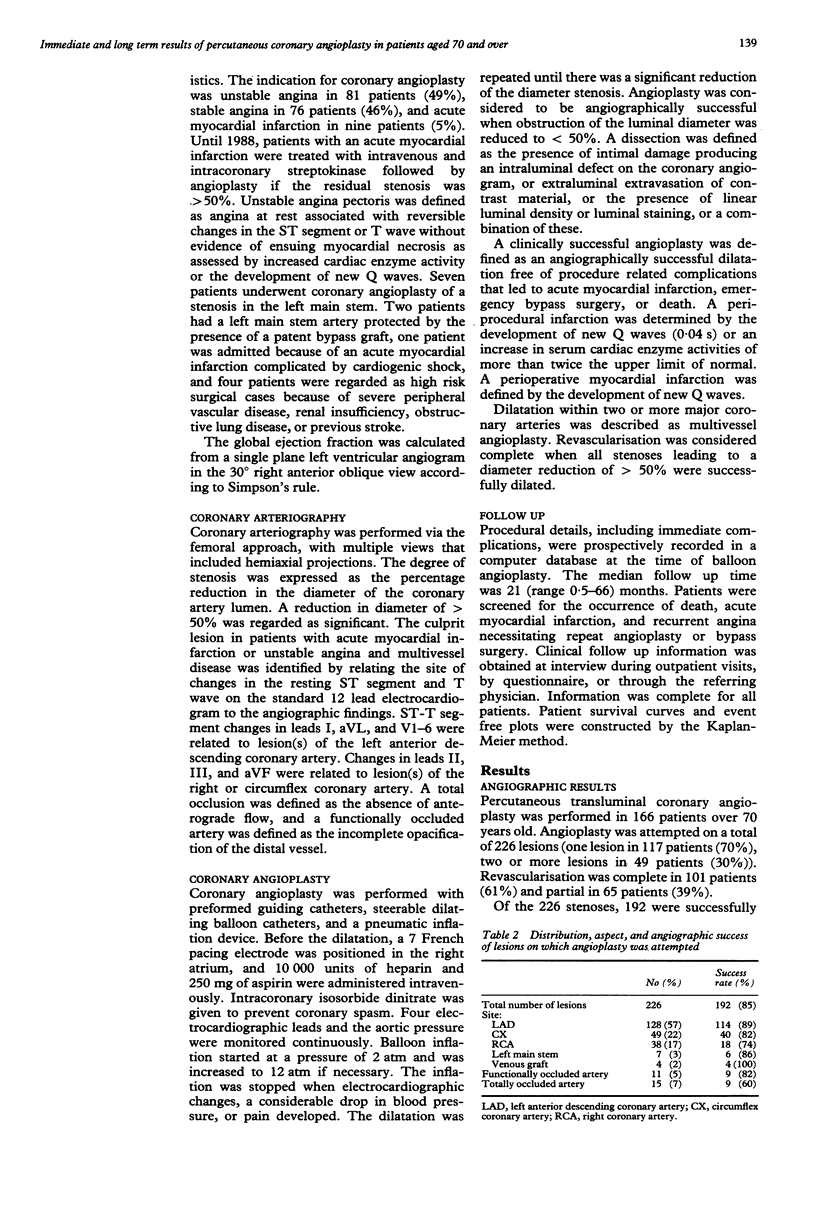
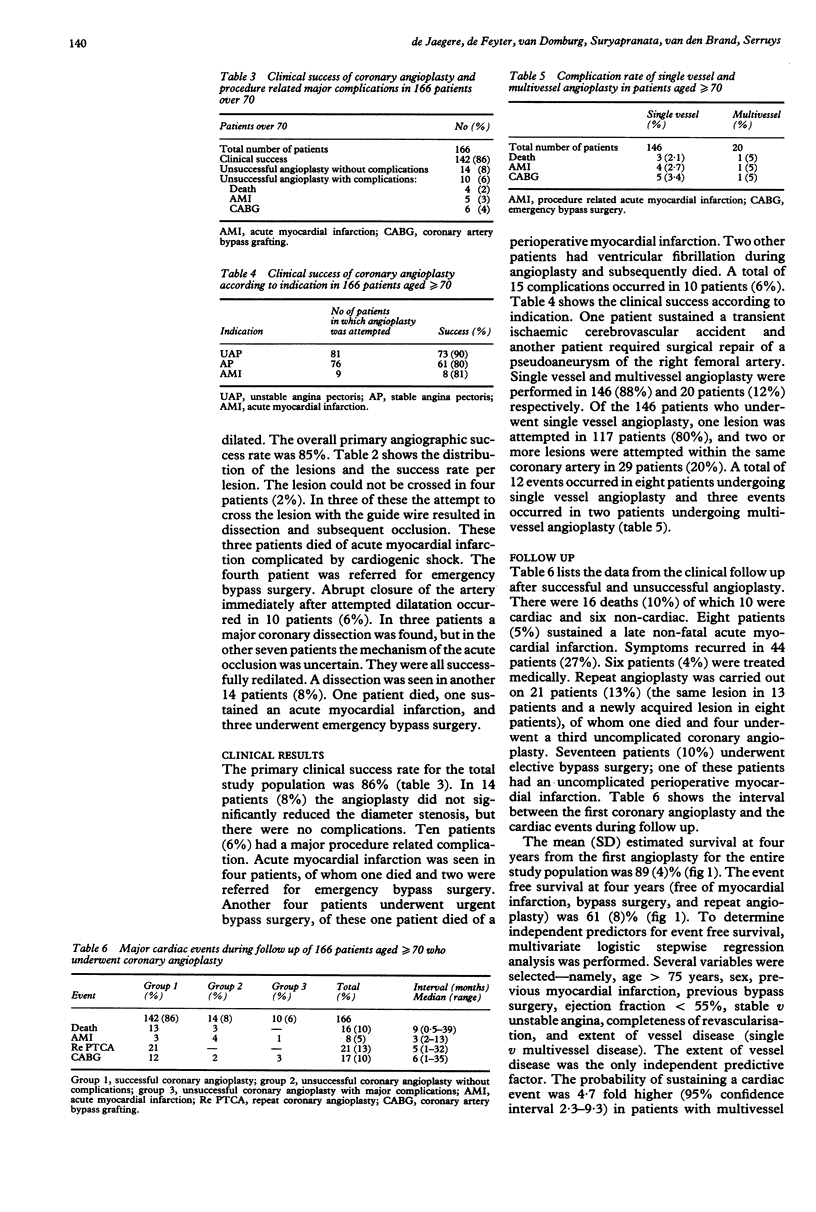
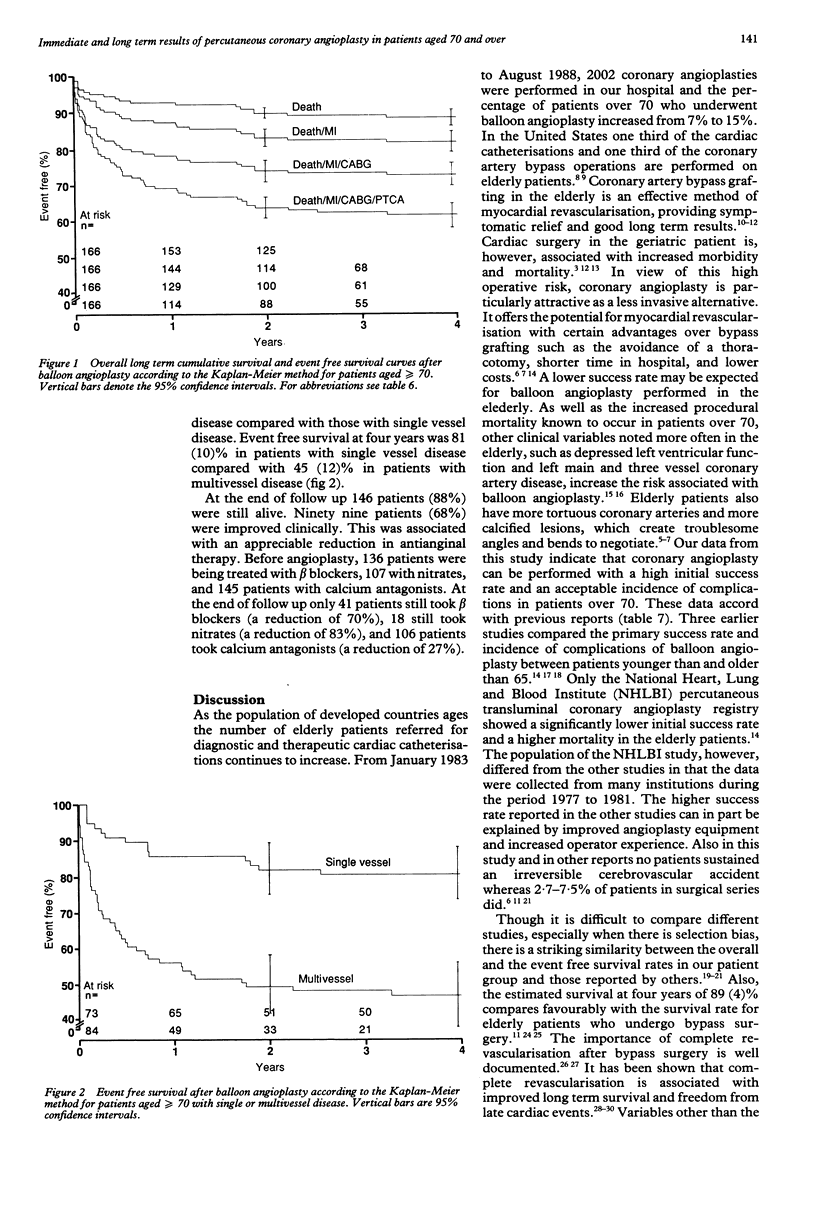
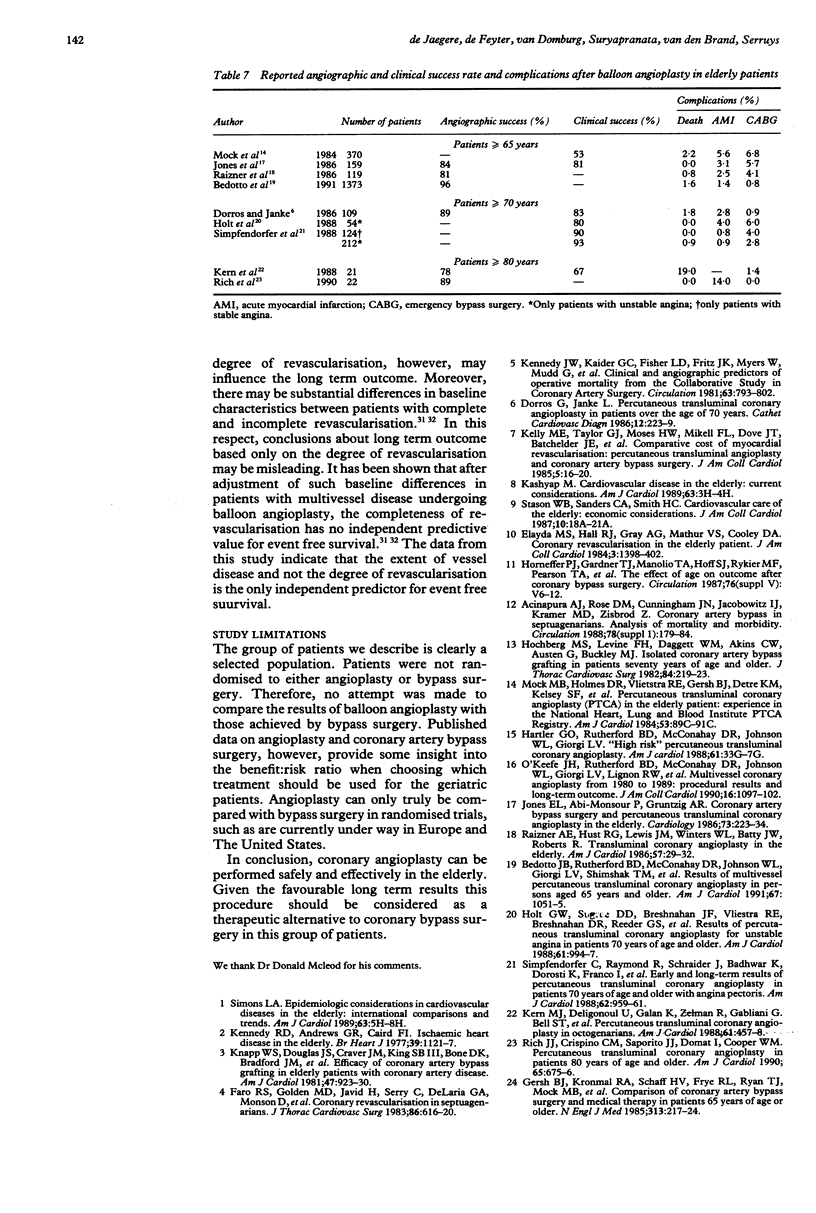
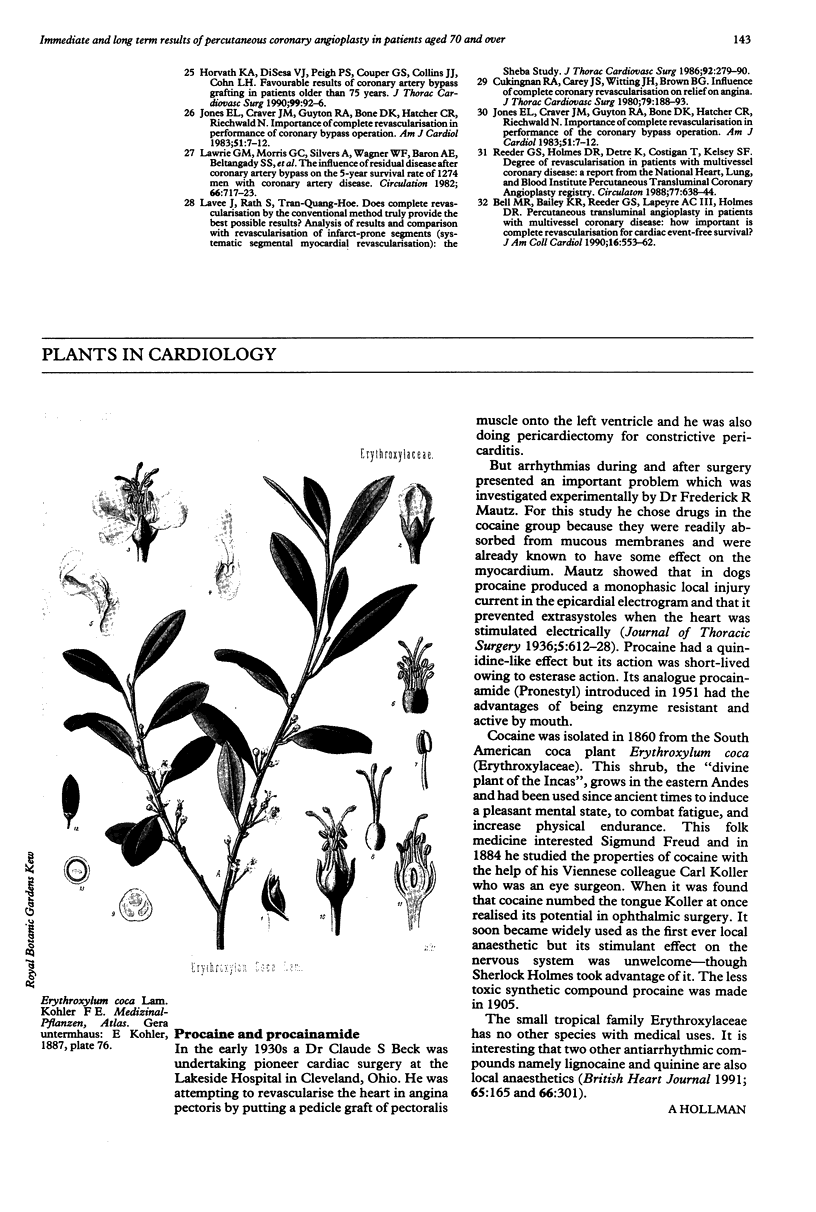
Images in this article
Selected References
These references are in PubMed. This may not be the complete list of references from this article.
- Bedotto J. B., Rutherford B. D., McConahay D. R., Johnson W. L., Giorgi L. V., Shimshak T. M., O'Keefe J. H., Ligon R. W., Hartzler G. O. Results of multivessel percutaneous transluminal coronary angioplasty in persons aged 65 years and older. Am J Cardiol. 1991 May 15;67(13):1051–1055. doi: 10.1016/0002-9149(91)90864-h. [DOI] [PubMed] [Google Scholar]
- Bell M. R., Bailey K. R., Reeder G. S., Lapeyre A. C., 3rd, Holmes D. R., Jr Percutaneous transluminal angioplasty in patients with multivessel coronary disease: how important is complete revascularization for cardiac event-free survival? J Am Coll Cardiol. 1990 Sep;16(3):553–562. doi: 10.1016/0735-1097(90)90342-m. [DOI] [PubMed] [Google Scholar]
- Cukingnan R. A., Carey J. S., Wittig J. H., Brown B. G. Influence of complete coronary revascularization on relief of angina. J Thorac Cardiovasc Surg. 1980 Feb;79(2):188–193. [PubMed] [Google Scholar]
- Dorros G., Janke L. Percutaneous transluminal coronary angioplasty in patients over the age of 70 years. Cathet Cardiovasc Diagn. 1986;12(4):223–229. doi: 10.1002/ccd.1810120405. [DOI] [PubMed] [Google Scholar]
- Elayda M. A., Hall R. J., Gray A. G., Mathur V. S., Cooley D. A. Coronary revascularization in the elderly patient. J Am Coll Cardiol. 1984 Jun;3(6):1398–1402. doi: 10.1016/s0735-1097(84)80277-6. [DOI] [PubMed] [Google Scholar]
- Faro R. S., Golden M. D., Javid H., Serry C., DeLaria G. A., Monson D., Weinberg M., Hunter J. A., Najafi H. Coronary revascularization in septuagenarians. J Thorac Cardiovasc Surg. 1983 Oct;86(4):616–620. [PubMed] [Google Scholar]
- Gersh B. J., Kronmal R. A., Schaff H. V., Frye R. L., Ryan T. J., Mock M. B., Myers W. O., Athearn M. W., Gosselin A. J., Kaiser G. C. Comparison of coronary artery bypass surgery and medical therapy in patients 65 years of age or older. A nonrandomized study from the Coronary Artery Surgery Study (CASS) registry. N Engl J Med. 1985 Jul 25;313(4):217–224. doi: 10.1056/NEJM198507253130403. [DOI] [PubMed] [Google Scholar]
- Hochberg M. S., Levine F. H., Daggett W. M., Akins C. W., Austen W. G., Buckley M. J. Isolated coronary artery bypass grafting in patients seventy years of age and older: early and late results. J Thorac Cardiovasc Surg. 1982 Aug;84(2):219–223. [PubMed] [Google Scholar]
- Holt G. W., Sugrue D. D., Bresnahan J. F., Vlietstra R. E., Bresnahan D. R., Reeder G. S., Holmes D. R., Jr Results of percutaneous transluminal coronary angioplasty for unstable angina pectoris in patients 70 years of age and older. Am J Cardiol. 1988 May 1;61(13):994–997. doi: 10.1016/0002-9149(88)90113-0. [DOI] [PubMed] [Google Scholar]
- Horvath K. A., DiSesa V. J., Peigh P. S., Couper G. S., Collins J. J., Jr, Cohn L. H. Favorable results of coronary artery bypass grafting in patients older than 75 years. J Thorac Cardiovasc Surg. 1990 Jan;99(1):92–96. [PubMed] [Google Scholar]
- Jones E. L., Abi-Mansour P., Grüntzig A. R. Coronary artery bypass surgery and percutaneous transluminal coronary angioplasty in the elderly patient. Cardiology. 1986;73(4-5):223–234. doi: 10.1159/000174016. [DOI] [PubMed] [Google Scholar]
- Jones E. L., Craver J. M., Guyton R. A., Bone D. K., Hatcher C. R., Jr, Riechwald N. Importance of complete revascularization in performance of the coronary bypass operation. Am J Cardiol. 1983 Jan 1;51(1):7–12. doi: 10.1016/s0002-9149(83)80003-4. [DOI] [PubMed] [Google Scholar]
- Jones E. L., Craver J. M., Guyton R. A., Bone D. K., Hatcher C. R., Jr, Riechwald N. Importance of complete revascularization in performance of the coronary bypass operation. Am J Cardiol. 1983 Jan 1;51(1):7–12. doi: 10.1016/s0002-9149(83)80003-4. [DOI] [PubMed] [Google Scholar]
- Kelly M. E., Taylor G. J., Moses H. W., Mikell F. L., Dove J. T., Batchelder J. E., Wellons H. A., Jr, Schneider J. A. Comparative cost of myocardial revascularization: percutaneous transluminal angioplasty and coronary artery bypass surgery. J Am Coll Cardiol. 1985 Jan;5(1):16–20. doi: 10.1016/s0735-1097(85)80079-6. [DOI] [PubMed] [Google Scholar]
- Kennedy J. W., Kaiser G. C., Fisher L. D., Fritz J. K., Myers W., Mudd J. G., Ryan T. J. Clinical and angiographic predictors of operative mortality from the collaborative study in coronary artery surgery (CASS). Circulation. 1981 Apr;63(4):793–802. doi: 10.1161/01.cir.63.4.793. [DOI] [PubMed] [Google Scholar]
- Knapp W. S., Douglas J. S., Jr, Craver J. M., Jones E. L., King S. B., 3rd, Bone D. K., Bradford J. M., Hatcher C. R., Jr Efficacy of coronary artery bypass grafting in elderly patients with coronary artery disease. Am J Cardiol. 1981 Apr;47(4):923–930. doi: 10.1016/0002-9149(81)90195-8. [DOI] [PubMed] [Google Scholar]
- Lavee J., Rath S., Tran-Quang-Hoa, Ra'anani P., Ruder A., Modan M., Neufeld H. N., Goor D. A. Does complete revascularization by the conventional method truly provide the best possible results? Analysis of results and comparison with revascularization of infarct-prone segments (systematic segmental myocardial revascularization): the Sheba Study. J Thorac Cardiovasc Surg. 1986 Aug;92(2):279–290. [PubMed] [Google Scholar]
- Lawrie G. M., Morris G. C., Jr, Silvers A., Wagner W. F., Baron A. E., Beltangady S. S., Glaeser D. H., Chapman D. W. The influence of residual disease after coronary bypass on the 5-year survival rate of 1274 men with coronary artery disease. Circulation. 1982 Oct;66(4):717–723. doi: 10.1161/01.cir.66.4.717. [DOI] [PubMed] [Google Scholar]
- O'Keefe J. H., Jr, Rutherford B. D., McConahay D. R., Johnson W. L., Jr, Giorgi L. V., Ligon R. W., Shimshak T. M., Hartzler G. O. Multivessel coronary angioplasty from 1980 to 1989: procedural results and long-term outcome. J Am Coll Cardiol. 1990 Nov;16(5):1097–1102. doi: 10.1016/0735-1097(90)90538-z. [DOI] [PubMed] [Google Scholar]
- Raizner A. E., Hust R. G., Lewis J. M., Winters W. L., Jr, Batty J. W., Roberts R. Transluminal coronary angioplasty in the elderly. Am J Cardiol. 1986 Jan 1;57(1):29–32. doi: 10.1016/0002-9149(86)90946-x. [DOI] [PubMed] [Google Scholar]
- Reeder G. S., Holmes D. R., Jr, Detre K., Costigan T., Kelsey S. F. Degree of revascularization in patients with multivessel coronary disease: a report from the National Heart, Lung, and Blood Institute Percutaneous Transluminal Coronary Angioplasty Registry. Circulation. 1988 Mar;77(3):638–644. doi: 10.1161/01.cir.77.3.638. [DOI] [PubMed] [Google Scholar]
- Rich J. J., Crispino C. M., Saporito J. J., Domat I., Cooper W. M. Percutaneous transluminal coronary angioplasty in patients 80 years of age and older. Am J Cardiol. 1990 Mar 1;65(9):675–676. doi: 10.1016/0002-9149(90)91051-7. [DOI] [PubMed] [Google Scholar]
- Simpfendorfer C., Raymond R., Schraider J., Badhwar K., Dorosti K., Franco I., Hollman J., Whitlow P. Early and long-term results of percutaneous transluminal coronary angioplasty in patients 70 years of age and older with angina pectoris. Am J Cardiol. 1988 Nov 1;62(13):959–961. doi: 10.1016/0002-9149(88)90901-0. [DOI] [PubMed] [Google Scholar]
- Sutton J., Gibson D. G. Measurement of postoperative pericardial pressure in man. Br Heart J. 1977 Jan;39(1):1–6. doi: 10.1136/hrt.39.1.1. [DOI] [PMC free article] [PubMed] [Google Scholar]



